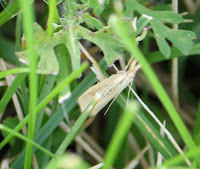 |
| I know this one at least! Chickweed Geometer (Haematopis grataria) |
Not anymore! That little green moth opened my eyes to another world. An often-nocturnal, skulking bunch of insects that normally escapes our attention, save when we see them fluttering around a porch light in the dark, or happen upon one of the magnificent giant specimens that may have expired in the parking lot at work (that one was an imperial moth).
 I splurged on a guide: Peterson's Field Guide to Moths of Northeastern North America. What a great investment! The images are all photos of live moths--none of those washed-out pinned specimens. And my favorite part: common names! Unlike the bee world, where few bees go by common names, the authors of this guide list a common name for every moth (if a moth didn't already have a widely-used common name, they assigned one). Weird, wonderful common names like Tearful Underwing, Maple Trumpet Skeletonizer, Somber Carpet, and Drab Prominent. They all sound like bugs I would like to get to know.
I splurged on a guide: Peterson's Field Guide to Moths of Northeastern North America. What a great investment! The images are all photos of live moths--none of those washed-out pinned specimens. And my favorite part: common names! Unlike the bee world, where few bees go by common names, the authors of this guide list a common name for every moth (if a moth didn't already have a widely-used common name, they assigned one). Weird, wonderful common names like Tearful Underwing, Maple Trumpet Skeletonizer, Somber Carpet, and Drab Prominent. They all sound like bugs I would like to get to know. Next time I went out on the Greenway, I was determined to try to photograph as many moths as I could. It proved tricky, since they--unlike their flashier butterfly kin--don't seem to want attention. Drab, cryptic coloration, small size, and a tendency to stick to grass and greenery instead of flowers all make it difficult to capture them in pixels. Not to mention their annoying habit of clinging to the bottom of a blade of grass instead of the top!
Next time I went out on the Greenway, I was determined to try to photograph as many moths as I could. It proved tricky, since they--unlike their flashier butterfly kin--don't seem to want attention. Drab, cryptic coloration, small size, and a tendency to stick to grass and greenery instead of flowers all make it difficult to capture them in pixels. Not to mention their annoying habit of clinging to the bottom of a blade of grass instead of the top!I was surprised at how many different kinds of moth I saw, just on a short jaunt. I am not yet quick enough with the guide to identify them, but identify them I shall. And if you are a neighbor, do not be alarmed if you see me out in the garden with a headlamp and camera; I'm just looking for moths!








Your curiosity and thirst for knowledge is so inspiring!
ReplyDelete